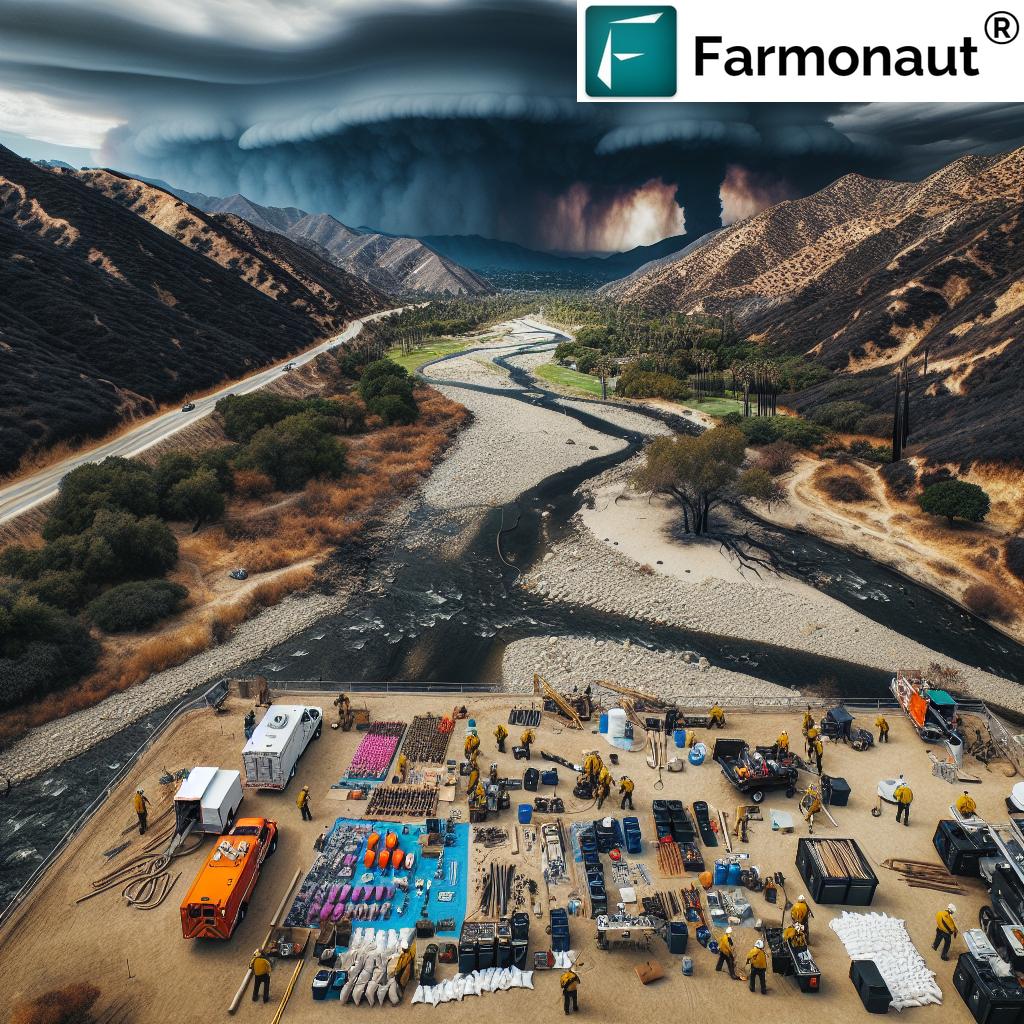Table of Contents
- Introduction: Hidden Dangers in Roseville Soil
- Quick Trivia: Lead in Roseville
- Why Is Roseville Facing Lead Contamination?
- Did You Know?
- 5 Urgent Risks of Lead Contamination in Roseville Soil
- Soil Testing for Lead: Steps Every Homeowner Must Take
- What Are Safe Lead Levels in Your Property?
- Comparison Table: Lead Levels and Health Risks
- Contaminated Soil Cleanup: Protecting Your Roseville Home
- Local & State Initiatives: Roseville Sampling and Support
- Essential Tips: How to Protect Your Family from Exposure
- FAQ: Lead Contamination in Roseville Soil
- Farmonaut & Modern Soil Health Monitoring
- Conclusion: Take Action for a Safer Roseville
Lead Contamination in Roseville Soil: 5 Urgent Risks for Homeowners
We often think of our homes in Roseville, Ohio, as safe havens nestled south of Zanesville amidst Ohio’s natural beauty. But for many families, elevated lead contamination in soil has become a hidden threat. Lead exposure isn’t just an environmental concern—it’s a direct danger to our health, property values, and peace of mind.
In this comprehensive guide, we’ll explore the 5 urgent risks every Roseville homeowner faces due to lead. You’ll discover actionable strategies, including crucial steps in soil testing for lead, understanding pottery shards lead risk, navigating environmental regulations, and effective contaminated soil cleanup. Our goal is clear: empower your family and neighborhood to stay safe, informed, and proactive.
Modern challenges require modern solutions—like satellite-based crop and soil monitoring platforms. Discover how Farmonaut’s large-scale farm management platform empowers farmers and property owners with real-time insights on soil health, resource management, and carbon footprint tracking. Developers and businesses can also integrate Farmonaut’s data into their systems via API—see our API access here and the developer documentation.
Why Is Roseville Facing Lead Contamination?
Roseville has a unique history, located south of Zanesville, where pottery once shaped the local economy. Decades of industrial waste from pottery operations, starting in the 1800s, left a legacy of lead-contaminated soil. Unglazed pottery shards, remnants of old factories, now litter yards and act as ongoing sources of contamination—especially if they are decomposing in various “stages of decomposition.”
The US Environmental Protection Agency (EPA) and Ohio EPA confirm that some of these shards (“pottery chuck”) contain high lead levels. Despite environmental regulations, the only way to know if your home is affected is through proper sampling and testing.
This contamination is not just a Roseville problem. Communities near historical industry sites face similar risks. Here, the situation is urgent because of the widespread presence of shards and inconsistent fill material, which was often distributed as construction or landscaping material in past decades.
“Pottery shards can increase soil lead levels by up to 30%, making thorough soil testing essential for homeowners.”
5 Urgent Risks of Lead Contamination in Roseville Soil
1. Severe Lead Exposure Health Concerns for Your Family
Lead is a potent and cumulative neurotoxin that poses serious health concerns, especially for children, pregnant women, and pets. Even at low parts per million (ppm) levels, lead can cause:
- Developmental issues (in children: learning disabilities, behavioral problems, reduced IQ)
- Nervous system, kidney, and blood function disorders
- Higher risk of hypertension, heart disease, and anemia in adults
- Irreversible impacts at elevated lead levels—even from occasional exposure
The U.S. EPA recommends that soil lead levels not exceed 200 ppm for residential use, particularly in play areas.
2. Pottery Shards Lead Risk: A Legacy Problem Hidden in Plain Sight
One of the most insidious issues in Roseville is the pottery shards lead risk. These unglazed shards, originating from old industrial operations, often contain elevated lead levels that leach into your yard. The EPA has confirmed that buried and surface-level shards show lead concentrations exceeding safe limits. Pottery-related “fill material” was indiscriminately used for landscaping and construction, especially in older homes.
Over time, rain, freezing, and thawing accelerate shard decomposition, releasing more lead into soil across varying contamination stages. This problem is unique because the contamination is not always visible—hidden beneath a layer of grass, mulch, or garden beds.
Use cases like these illustrate why modern soil and crop monitoring is vital. Technologies such as Farmonaut’s carbon footprinting tools can help landowners monitor environmental impact — or choose blockchain-based product traceability for supply chain transparency in the agricultural sector.
3. Negative Impact on Property Value and Real Estate Transactions
The discovery of elevated lead levels in your yard can drastically affect your property’s market value. Since 2024, buyers and realtors have shown greater awareness of environmental contamination, driving:
- Disclosures of soil contamination before real estate closings
- Increased demand for soil testing for lead reports
- Possible refusal of mortgage or insurance coverage
- Legal issues and unexpected cleanup costs for sellers
The presence of pottery shards and failure to remediate contaminated soil are now major red flags for potential buyers.
4. Unseen Spread: Tracking Lead Dust and Soil Particles Indoors
Even if you don’t use your yard heavily, simply walking, digging, or gardening can bring contaminated lead dust into your home. This so-called “track-in” is a primary route of household lead exposure, especially for young children who crawl or play on the floor. The EPA and local officials strongly urge residents to:
- Remove dirty shoes, gloves, and outerwear before entering
- Wipe pets’ paws
- Use HEPA vacuums and regularly damp mop floors
- Wash hands with soap and water before eating or after yard work
These steps are simple but essential to prevent the cumulative increase of lead dust inside the home.
5. Regulatory, Cleanup, and Long-Term Costs
Failure to address lead contamination in soil can result in:
- Regulatory action—The Ohio EPA and US EPA are monitoring and may require cleanup if your property exceeds safe limits.
- Financial burden—Remediation and contaminated soil cleanup costs can range from targeted soil removal to full yard excavation and replacement.
- Ongoing testing and monitoring—Annual or post-remediation checks may be mandated to ensure persistence of low lead levels.
- Uncertainty—Guidelines and safe levels may change as new research emerges, requiring additional efforts.
For residents of the village of Roseville, knowing these risks is the first step to proactive, cost-sensitive decision-making when it comes to their homes and families.
Comparison Table of Lead Contamination Levels and Associated Health Risks
| Lead in Soil (ppm) | Potential Health Impacts: Children | Potential Health Impacts: Adults | EPA/Regulatory Safe Limits | Recommended Homeowner Actions |
|---|---|---|---|---|
| <100 ppm | Generally considered safe. Minimal risk. Maintain good hygiene, especially for children and pets. | No significant health impact. Best practices: avoid unnecessary exposure. | EPA recommends <200 ppm for play areas; 400 ppm for general areas. | Continue regular monitoring. No action needed unless using soil for food gardening. |
| 100–400 ppm | Low to moderate risk. Some increased risk of developmental delay with chronic exposure. | Adults generally tolerate low exposures, but pregnant women at higher risk. | EPA action level: 400 ppm for general play areas. | Consider covering soil (mulch, grass). Limit bare soil exposure. Conduct periodic retesting. |
| 400–1,000 ppm | High risk. Strong evidence for cognitive, behavioral, and physical health problems. | Elevated blood lead risk for gardeners, frequent yard users. | Well above EPA limit. Remediation strongly advised. | Avoid contact with soil. Initiate clean-up. Use raised/garden beds and HEPA vacuum inside home. |
| >1,000 ppm | Extremely high risk. Acute poisoning possible. Neurological and organ damage can occur. | Severe health risks even with moderate exposure. Immediate action needed. | Far exceeds all residential guidelines. | Professional remediation is mandatory. Contact EPA/local authorities immediately. |
Soil Testing for Lead: Steps Every Homeowner Must Take
The only way to know if elevated lead levels are present in your Roseville yard is to systematically test the soil—especially if pottery shards or old fill material are present. Here’s how to protect your property and your family:
-
Collect Soil Samples Properly:
- Use clean tools and gloves to avoid cross-contamination (not your gardening trowel).
- Sample from multiple locations (at least 3-5 spots per 1,000 sqft)—front yard, backyard, near foundations, garden beds.
- Target areas near pottery shards, visible fill material, or where children/pets play.
- Sample depth: generally 0–2 inches (surface), and 2–6 inches (subsurface).
- Label Each Sample: Use plastic bags and note the sample location, depth, and date.
- Submit for Laboratory Testing: The US EPA, the Ohio EPA, or a certified environmental laboratory can analyze samples for lead levels (report will be in parts per million — ppm).
- Interpret Results: Refer to the EPA’s recommended safe levels in the comparison table above. Discuss “hot spots” with environmental officials—especially if >200 ppm in a play area or >400 ppm in a general yard.
- Access Free Soil Sampling Programs: The State of Ohio, via Gov. Mike DeWine, set aside $1.1 million to fund lead soil testing for up to 700 properties in Roseville. Apply for free lead soil sampling before the end of April.
For detailed digital land analysis, advanced users and farmers can leverage Farmonaut’s satellite-based monitoring tools to track soil health, moisture, and contamination risk.
What Are Safe Lead Levels in Your Property?
The EPA recommends:
- <200 ppm for areas used for growing produce or where children frequently play
- 400 ppm for general residential yard areas
If your yard tests above these numbers, you face serious lead exposure health concerns—especially for young children and pregnant women. It’s critical that you begin contaminated soil cleanup right away.
Satellite monitoring can support environmental consultants and large property owners—see how Farmonaut’s fleet and resource management tools help with precise land tracking and environmental impact checks.
Local and State Initiatives: Roseville Soil Sampling and Homeowner Support
Ohio’s approach to lead contamination in Roseville is multi-faceted:
- Free Lead Soil Sampling: In March 2024, the state set aside $1.1 million for comprehensive property sampling. The US EPA is responsible for the clean-up, while the Ohio EPA conducts sampling.
- How to Apply: Homeowners must apply by completing access forms, available online or at designated locations. Submit by mail or in-person before the end of April.
- Sampling Process: EPA officials will conduct systematic sampling, analyze findings, and recommend next steps.
- Water Monitoring: While the primary concern is soil (not water), Roseville’s municipal water supply is regularly tested and compliant with federal standards since 2023. If concerned, arrange private water testing.
- Support for Residents: The EPA is offering free HEPA vacuums (removes 99.97% of dust particles) for affected families, along with guidance on best cleaning practices.
For continuing concerns, explore how satellite-verified crop and soil profiles can streamline property insurance or environmental compliance.
Contaminated Soil Cleanup: Protecting Your Roseville Home
Following soil testing for lead, if your property reveals elevated or unsafe lead levels, here’s your action plan:
Steps for Effective Contaminated Soil Cleanup
- Limit Direct Exposure: Block off or cover contaminated areas with mulch, sod, gravel, or geo-textile fabric. Prevent children and pets from playing in affected zones.
- Remove Contaminated Soil (“Hot Spot” Remediation): For heavily-affected areas (e.g., where shards are found or samples show >400 ppm), physically remove and dispose of several inches of soil (consult local disposal regulations).
- Add Clean Topsoil: Replace removed soil with certified clean fill or compost.
- Use Barriers: Install landscape fabric, sod, or pave over high-risk areas as a quick, temporary fix; this reduces contact until full remediation is completed.
- Change Gardening Practices: Switch to raised garden beds with clean soil for food crops instead of planting directly in contaminated soil.
- Implement Ongoing Monitoring: After cleanup, retest soil annually to confirm levels stay below regulatory thresholds.
- Follow EPA Cleanup Guidance: Use only certified professionals for high-lead sites. If unsure, contact the EPA or local health department.
Essential Tips: How to Protect Your Family from Lead in Soil
- Wash hands with soap and water after outdoor play, gardening, or yard work—especially before meals.
- Remove shoes, gloves, and outerwear before entering the home to prevent tracking lead dust indoors.
- Clean floors, porches, and surfaces regularly with a HEPA vacuum and wet mopping methods.
- Discourage digging or bare-soil play where pottery shards or fill material are present.
- Wipe pets’ paws and fur before they enter the house.
- Grow edible plants only in raised beds with clean soil.
- Keep play areas covered with fresh sod, mulch, or artificial turf.
FAQ: Lead Contamination in Roseville Soil
Pottery shards from historical pottery industry waste often contain lead. Over decades, these fragments break down, releasing lead that mixes with surrounding soil, especially after rain, thaw, or digging.
Q2: How do I apply for free lead soil sampling in Roseville?
Contact the Ohio EPA or local village office for access forms. You can apply online or pick up forms at designated locations. Submit by the stated deadline to have your property tested for free.
Q3: What lead levels should I be concerned about?
The EPA’s main guidelines: less than 200 ppm for play/garden areas, 400 ppm for general yards. Higher concentrations require cleanup to prevent long-term health impacts.
Q4: Is my drinking water at risk in Roseville?
Roseville’s municipal water is regularly tested and meets all standards as of 2024. Lead here is primarily a soil issue. If your home uses a private well or has plumbing >40 years old, consider separate water tests for lead.
Q5: How does Farmonaut help homeowners?
Farmonaut offers advanced land and crop health monitoring using satellite data. While it does not sell or remediate soil, it enables farmers and landowners to track environmental changes, monitor risk zones, and plan sustainability actions efficiently through AI-based insights and digital mapping.
Farmonaut: Affordable Subscriptions for Modern Land Monitoring
Whether managing a farm, woodland, or environmental project, Farmonaut’s flexible subscriptions deliver up-to-date analytics and monitoring at scale. Enjoy real-time insights, crop and soil mapping, and AI-powered recommendations.
Farmonaut & Modern Soil Health Monitoring
Facing environmental risks and tightening environmental regulations for soil contamination, residents, farmers, and corporate landowners can benefit from technology that delivers actionable insights. Farmonaut’s mission is to bridge this gap with satellite-powered, AI-driven tools:
- Monitor crop health and soil quality in real time—get alerts for abnormal zones or moisture shifts.
- Access resource management features—track machinery, monitor input usage and improve operational efficiency on farms and estates.
- Enhance environmental sustainability—leverage carbon footprinting and traceability modules for compliance, consumer trust, and farm-to-market reporting.
The Farmonaut platform is available via Web App, Android, and iOS—designed to be affordable and accessible for all, from smallholder landowners to large-scale operators and environmental consultants.
Conclusion: Take Action for a Safer, Sustainable Roseville
Lead contamination in Roseville soil is a real and urgent public health concern, with pottery shards and old fill materials acting as an ongoing source. The risks are serious—spanning health, property, and environmental sustainability—but with the right knowledge, vigilant testing, and proactive remediation, every homeowner can protect their family and community.
If you live in the village of Roseville, apply for free lead soil sampling today. Embrace the latest digital monitoring tools, prioritize regular safe practices inside and outside your home, and stay informed on EPA guidelines.
Environmental problems don’t resolve overnight, but as a community, we have the knowledge, resources, and technology to reclaim our homes from the toxic legacy of the past while building a safer, greener future.

















